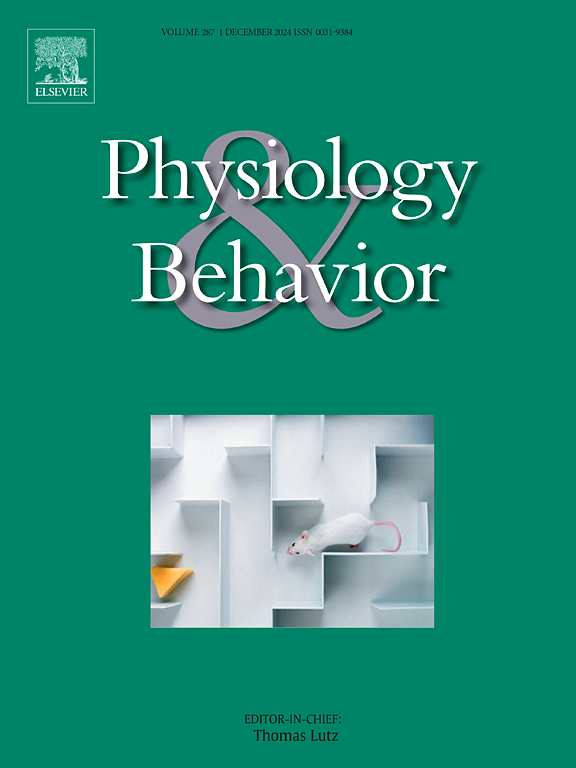在帕金森病的Pink1-/-大鼠模型中,性别差异区分了四种基于物体识别的记忆任务的表现。
IF 2.5
3区 医学
Q2 BEHAVIORAL SCIENCES
引用次数: 0
摘要
帕金森病(PD)男性患者比女性患者更早出现认知和记忆方面的前驱非运动障碍。这些所谓的轻度损伤预示着未来受冻、跌倒和患pd相关痴呆的风险。此外,由于大多数治疗无效,这些症状往往持续存在并逐渐恶化。因此,迫切需要更好地理解和更好地治疗这些迹象。这项研究强调了敲除pten诱导的激酶1基因(Pink1-/-)的大鼠可以作为模拟PD轻度认知缺陷及其性别差异的模型的新途径。具体来说,纵向行为测试证实,雄性Pink1-/-大鼠在5个月大的时候在新物体识别和新物体定位任务中出现了显著的缺陷,但雌性Pink1-/-在12个月大的时候在这些任务和物体就位任务中没有受损。此外,情景样记忆测试显示,在Pink1-/- 3个月大的男性中,所有三个记忆域都存在缺陷。然而,在Pink1-/-雌性大鼠中,在7个月大时首次观察到不显著的情景记忆障碍,到12个月大时,雌性大鼠在“什么”、“在哪里”和“何时”领域发展为显著的缺陷。总之,这些数据表明,Pink1-/-大鼠模型显示男性PD患者更容易出现认知和记忆缺陷;随着年龄的增长,女性PD患者出现高阶缺陷的风险增加;其他特征包括早期/最早发作,将情景记忆障碍与这种疾病中其他有风险的认知操作区分开来。本文章由计算机程序翻译,如有差异,请以英文原文为准。
Sex differences distinguish performance in four object recognition-based memory tasks in the Pink1-/- rat model of Parkinson’s disease
Male more than female patients with Parkinson’s disease (PD) experience early, sometimes prodromal non-motor deficits involving cognition and memory. These so-called mild impairments predict future risk of freezing, falls and developing PD-related dementia. Moreover, because most treatments are ineffective, these symptoms often persist and progressively worsen. Thus, there are urgent needs to better understand and better treat these signs. The work presented here highlights new ways in which rats with knockout of PTEN-induced putative kinase 1 gene (Pink1-/-) can serve as models that emulate PD’s mild cognitive deficits and their sex differences. Specifically, longitudinal behavioral testing confirmed that male Pink1-/- rats developed significant deficits in Novel Object Recognition and Novel Object Location tasks by 5 months old, but that female Pink1-/- were unimpaired in these and in the Object-in-Place task through testing at 12 months of age. Further, What, Where, When Episodic-like Memory testing showed that deficits in all three memory domains were present in Pink1-/- males by 3 months of age. However, in Pink1-/- females, non-significant episodic memory impairments were first observed at 7 months of age which progressed to significant deficits in ‘What’, ‘Where’ and ‘When’ domains by the time female rats were 12 months old. Together, these data show that Pink1-/- rats model the greater vulnerability of male PD patients to cognitive and memory deficits; the increasing risk for higher-order deficits in female PD patients with age; and other features including the early/earliest onset that distinguishes episodic memory impairments from other at-risk cognitive operations in this disorder.
求助全文
通过发布文献求助,成功后即可免费获取论文全文。
去求助
来源期刊

Physiology & Behavior
医学-行为科学
CiteScore
5.70
自引率
3.40%
发文量
274
审稿时长
47 days
期刊介绍:
Physiology & Behavior is aimed at the causal physiological mechanisms of behavior and its modulation by environmental factors. The journal invites original reports in the broad area of behavioral and cognitive neuroscience, in which at least one variable is physiological and the primary emphasis and theoretical context are behavioral. The range of subjects includes behavioral neuroendocrinology, psychoneuroimmunology, learning and memory, ingestion, social behavior, and studies related to the mechanisms of psychopathology. Contemporary reviews and theoretical articles are welcomed and the Editors invite such proposals from interested authors.
 求助内容:
求助内容: 应助结果提醒方式:
应助结果提醒方式:


